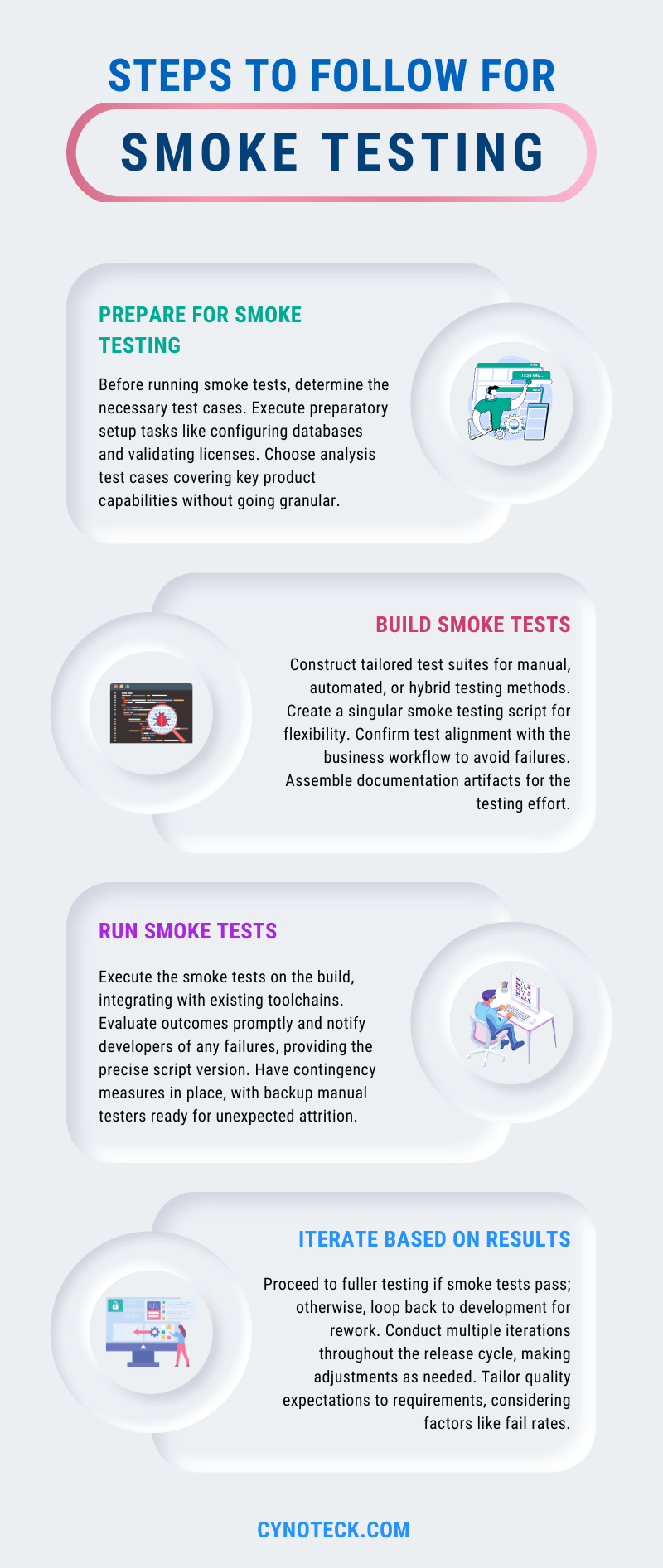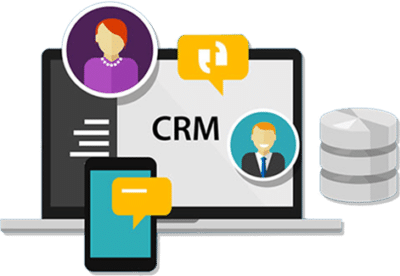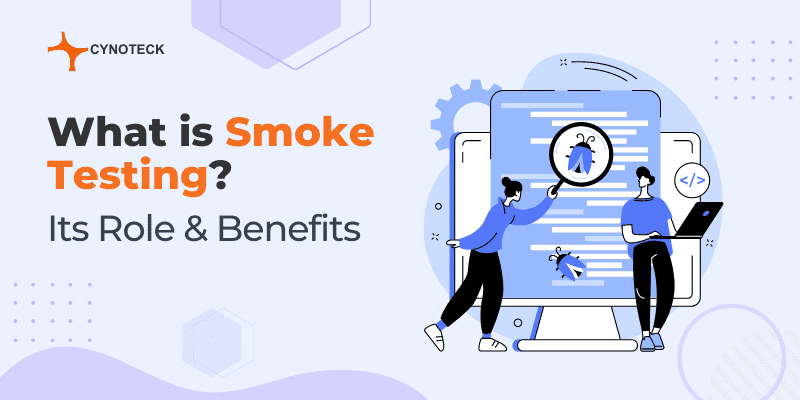All the industries are today focused on producing and delivering the best quality outcomes to their customers and their markets, and the same goes with the software development sector as well and in order to achieve that, productive software testing is all that is required as it is the key element to reach the target.
There are numerous ways to test the software that includes unit testing, API testing, sanity testing, smoke testing, integration testing, functional and non – functional testing, and so on. Among all these listed ways, smoke testing is the one that is very crucial in its own way and this blog is focused on it that will cover different aspects of this methodology.
What is Smoke Testing?
Smoke testing is a preliminary level of testing that is conducted to check the basic functionality of a software application. The term “smoke testing” is derived from the electronics industry, where a device is turned on and checked for smoke coming out of it, which would indicate a major failure.
In the context of software testing, smoke testing involves running the most important functions of a program to ascertain whether it is stable enough for more rigorous testing.
The primary goal of smoke testing is to determine whether the critical functionalities of the software work as expected. It is usually performed before more comprehensive testing, such as regression testing or functional testing, to save time and effort by identifying major issues early in the development cycle.
It is not exhaustive and does not delve into the finer details of the software; rather, it focuses on ensuring that the basic features are operational.
By conducting smoke testing, software development teams can catch major defects early, allowing for quicker resolution and preventing the waste of resources on more in-depth testing of a fundamentally flawed product. This approach helps in maintaining the overall quality and reliability of the software.
Role Of Smoke Testing
The smoke testing cycle that is performed by QA teams in the test environment ensures that if the deployed build is achieving the core target and whether it should be tested further or not.
In other words, if the build fails the test scenario of core functionality, then it will be rejected immediately by the QA team, and they will stop testing it. It is drafted to ensure the core functionality of the fresh build.
This kind of process and verification method also checks the stability and complete functional aspect of the build and if it fails the smoke testing, then there is no meaning to go ahead with testing it.
Hence, in a nutshell, the smoke testing is very promising to confirm if a build is stable enough to be tested further.
Also, read: The new big things in CodeIgniter 4
Smoke Testing Preview
With smoke testing, most of the build issues can be identified in the early stages of the program development and can be helpful for the correction of the same so it can be said that smoke testing is a frequent regression test of the prime functionalities and manifests if the build is ready to carry out the testing further.
This method can be adopted by the developers and the build passes the test then only it can be deployed for further testing else should be rejected.
Here is a pictorial representation for the above:

When to do Smoke Test?
Smoke testing should be performed at the initial phase of the testing life cycle as it checks very soon the productivity of the build and ensures if the elementary requirements can be fulfilled or not. Whenever a fresh build is deployed, or any change has been made in the build then smoke testing should be carried out.
Software development is always divided into different sprints so that all the corners are covered hence it is important that each sprint has a stable code so smoke test takes very little time to fulfil this need before the regression testing and, in this way, we also save our precious time as well.
The objective of smoke testing is to test the important functionalities of a system and not to execute the exhaustive test scenarios.
Also, read: 7 Signs your business needs to upgrade to a new CRM
What if there is no Smoke Test?
It is necessary for every fresh build being deployed to be tested aggressively with smoke testing because it is possible that without it, certain critical bugs would not be detected and can be a showstopper later in other test cycles. It is also possible that without smoke testing, an integration error can be generated.
How can the Smoke Testing Procedure be Automated?
Automated smoke tests can run frequently in production, safeguarding critical functions and triggering alerts for rapid defect resolution before major customer impact. For new builds readied for deployment, automation provides immediate validation versus manual testing.
In place of manual execution, automated smoke test suites are triggered against fresh software builds pre-release. An optimal automated smoke testing portfolio contains modest yet enough quick-running tests, typically 20-50. Too few or too many can undermine this preliminary verification.
Numerous test automation tools exist across countless vendor promises. Leading options center on browser test automation, with Selenium topping frameworks. Executing these validations catches software bugs early. Entire automated smoke testing cycles may be completed in days.
For first-time software releases, automated smoke tests should provide wide system coverage. This allows developers to iterate rapidly on incremental smoke testing absent entire application stability. More areas can be covered automatically versus manual testing cadences.
Also, read: Testing a Customized MS Dynamics CRM
Benefits of Smoke Testing
Through smoke testing, developers can unlock the following benefits:
- Faster Bug Resolution for New and Regression Issues
By conducting smoke testing, the development team can promptly initiate debugging and root cause analysis for any newly discovered or recurring issues. Unlike the comprehensive test suite, smoke testing provides broad coverage but limited depth.
This allows the QA team to continue regression testing on a build with some stability while developers address any defects identified during smoke tests, resulting in increased efficiency.
Once the developers rectify these issues, they can then concentrate on resolving any bugs uncovered during regression testing.
- Enhanced Testing Effectiveness
Utilizing smoke testing enables the testing team to conserve resources. It is unproductive to invest effort in a faulty build that barely functions. Therefore, relying on smoke testing to detect instabilities is preferred.
This approach allows developers to eliminate these issues early, ensuring that each new release in agile software development, which builds upon the previous one, is robust and free of bugs.
In essence, smoke tests enhance the reliability of the core code and facilitate smoother integration of fresh builds by reducing the likelihood of significant issues.
- Early Detection of Critical Bugs
One of the most notable advantages of smoke testing is its ability to identify issues in the fundamental functionalities of the system at an early stage.
As reported by some Functionize clients, the implementation and execution of an effective smoke testing suite enable them to detect and address up to 80% of the encountered defects.
This aligns well with the Pareto principle, where smoke tests, despite covering only 20% or less of the total test cases for many teams, manage to uncover 80% or more of the defects. This alone justifies the value of smoke testing efforts.
- Reduction of Integration-Related Risks
Smoke testing proves to be advantageous for integrations that involve the addition of new functionalities to an existing software program, a common scenario in the utilization of CI/CD tools and methodologies.
Each new build, that introduces these features, must undergo testing. By incorporating smoke testing into the testing process, one can ensure that every component of the integrated program has been thoroughly tested.
Consequently, the overall integration becomes smoother and more stable. Furthermore, by having evidence of the reliability and absence of software-breaking flaws in the new content, the likelihood of the original build rejecting the updated material is significantly reduced.
- Time and Resource Efficiency
Smoke tests typically range from 15 minutes to 2 hours, depending on the complexity of the system (in the worst-case scenario). Automating smoke testing can significantly reduce the time required.
By swiftly and effectively identifying the causes of issues through smoke testing, teams can spend less time scouring the code for potential culprits, resulting in cost and time savings, particularly for teams with limited automation usage.
Furthermore, complete automation of the smoke testing process can yield even more substantial benefits.
- Automation Potential
Automation offers significant savings in both time and resources. Bots are inherently faster than humans in executing tasks and workflows.
While tasks requiring human creativity cannot be automated, AI-based systems can conduct smoke testing, leading to a significant reduction in testing time.
The advantages of automation extend to ensuring consistent execution of procedures, eliminating the unpredictability of human error, and increasing the frequency of testing.
- Adaptability
The flexibility and agility of the smoke testing process allow for maximum utilization without any automation. With three different types of smoke tests available, there is always at least one that suits specific requirements.
Not everyone needs to rely on automation, and developers can still conduct manual smoke tests if they opt against automation.
As detailed in the section elaborating on this approach, manual smoke testing has its own set of advantages. Additionally, smoke testing is not limited to automated or manual methods, showcasing its versatility.
Also, read: Model-Based Testing: The new era of Software Automation
Steps to follow for Smoke Testing:

1. Prepare for Smoke Testing
Before running a smoke test, one must determine the necessary number of test cases to validate core functionality. Without an adequate number mapped out upfront, progress may be delayed recalculating.
After a successful build but preceding testing, preparatory setup steps may be required—configuring databases, launching servers, installing licenses, etc.
One should complete requisite setup tasks post-build and pre-testing. This includes validating licenses, storing data across environments, initializing servers, and related tasks.
The first step for all should be choosing analysis test cases. Selected tests should provide coverage of key product capabilities without going granular into less critical flows. More tests drive more robust, actionable outcomes.
2. Build Smoke Tests
Next comes constructing needed test suites for the smoke testing protocol. This requires finalizing test cases and scripts tailored to chosen testing methods (manual, automated, or hybrid). Following test case selection, the next milestone is authoring executable test scripts.
A singular smoke testing script is the best practice, improving flexibility in testing variations. The subsequent action is assembling documentation artifacts required for the smoke testing effort. For example, by accelerating command line tools, one would download numerous test files locally to disk.
Required download commands differ from pending software. Confirming test alignment to the business workflow is critical as part of this. If unable to complete an end-to-end workflow, the test will fail.
3. Run Smoke Tests
The next milestone is executing the authored smoke tests on the build. Post-execution, outcomes can be evaluated. Leveraging a single smoke testing script affords more flexibility. Initiating test execution should integrate with existing build toolchains, storing results alongside other build artifacts for comparison.
If any test failures surface, it’s critical to notify developers, passing along the precise script version. Above all, rigorously adhere to the processes laid out in prior steps. For example, having backup manual testers on standby to handle unexpected tester attrition.
By this point, contingency mechanisms for such scenarios should be in place, though surprises inevitably happen. Actively monitoring and watching for issues is key given this.
4. Iterate Based on Results
With a successful smoke test, the build can progress to fuller functional and unit testing. Alternatively, failed tests loop back to development for rework. Undoubtedly, smoke testing occurs in multiples over any release cycle. As such, don’t hesitate to revert to designers when adjustments are needed.
Studying smoke test outputs simplifies determining pass vs. fail build quality. For a SaaS company, quality bars may be higher, with a 10% fail rate prompting a rebuild. However, less stability-sensitive scenarios may tolerate the same rate.
The key is tailoring expectations to requirements during evaluation. Once smoke testing concludes, a cleanup of testing artifacts becomes necessary.
Also, read: 11 questions on QA and testing to ask your App development partner
Types of Smoke Testing:
There are three main approaches to smoke testing: automated, manual, and hybrid. Each has its strengths and applications.
- Automated Testing:
Automated smoke testing utilizes software tools to run tests on a new build. It is extremely fast and efficient, allowing developers to quickly check new builds before deployment. However, automated tests may miss subtle issues that a human tester would notice. Automation works best for regression testing and confirming basic functionality. - Manual Testing:
Manual testing, on the other hand, relies on human testers designing and executing test cases. This allows for more exploratory testing and identification of edge case issues. However, manual testing is slower and more resource intensive. It works best when test cases cannot be easily automated. - Hybrid Testing:
Hybrid testing combines automation and manual testing. Some baseline test cases are run automatically, while testers manually check more complex application behavior and workflows. This provides both speed and depth of testing. The downside is the complexity of implementing and maintaining a hybrid approach.
Conclusion
The practice of conducting smoke testing on every build is crucial for identifying defects at an early stage. This activity serves as the final checkpoint before a software build progresses to the system stage, ensuring that only stable and functional versions are subjected to further testing. Whether for new developments or major and minor releases, the consistent application of smoke testing is essential for maintaining the integrity of the software.
Before initiating smoke testing, the QA team must verify the correct build version of the application under test, a straightforward process that efficiently assesses the application’s stability. By promptly identifying critical issues, smoke testing minimizes test effort and contributes to overall improvements in application quality. Whether performed manually or through automation, the choice of smoke testing method can be tailored to the specific needs of the client and the organization.
In conclusion, the regular execution of smoke testing not only serves as a safeguard against major defects but also streamlines the testing process, ultimately enhancing the reliability and performance of the software.

Automated Software Testing Services
With automated testing tools like selenium, You can increase the effectiveness, efficiency and test coverage of your software application. Cynoteck technology help organizations deliver batter quality software/applications by using automated testing tools. get in touch with us for any assistance.





Thanks for sharing this informative blog. There are many benefits with smoke testing at an early stage of the product development. Hence, this testing process should be adopted as it quickly as possible.